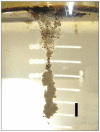Microbial activities and dissolved organic matter dynamics in oil-contaminated surface seawater from the Deepwater Horizon oil spill site
- PMID: 22509359
- PMCID: PMC3324544
- DOI: 10.1371/journal.pone.0034816
Microbial activities and dissolved organic matter dynamics in oil-contaminated surface seawater from the Deepwater Horizon oil spill site
Abstract
The Deepwater Horizon oil spill triggered a complex cascade of microbial responses that reshaped the dynamics of heterotrophic carbon degradation and the turnover of dissolved organic carbon (DOC) in oil contaminated waters. Our results from 21-day laboratory incubations in rotating glass bottles (roller bottles) demonstrate that microbial dynamics and carbon flux in oil-contaminated surface water sampled near the spill site two weeks after the onset of the blowout were greatly affected by activities of microbes associated with macroscopic oil aggregates. Roller bottles with oil-amended water showed rapid formation of oil aggregates that were similar in size and appearance compared to oil aggregates observed in surface waters near the spill site. Oil aggregates that formed in roller bottles were densely colonized by heterotrophic bacteria, exhibiting high rates of enzymatic activity (lipase hydrolysis) indicative of oil degradation. Ambient waters surrounding aggregates also showed enhanced microbial activities not directly associated with primary oil-degradation (β-glucosidase; peptidase), as well as a twofold increase in DOC. Concurrent changes in fluorescence properties of colored dissolved organic matter (CDOM) suggest an increase in oil-derived, aromatic hydrocarbons in the DOC pool. Thus our data indicate that oil aggregates mediate, by two distinct mechanisms, the transfer of hydrocarbons to the deep sea: a microbially-derived flux of oil-derived DOC from sinking oil aggregates into the ambient water column, and rapid sedimentation of the oil aggregates themselves, serving as vehicles for oily particulate matter as well as oil aggregate-associated microbial communities.
Conflict of interest statement
Figures






References
-
- McNutt M, Camilli R, Guthrie G, Hsieh P, Labson V, et al. Assessment of flow rate estimates for the Deepwater Horizon/Macondo well oil spill. 2011. Flow rate technical group report to the national incident command, interagency solutions group, March 10, 2011.
-
- Diercks AR, Highsmith RC, Asper VL, Joung D, Zhou Z, et al. Characterization of subsurface polycyclic aromatic hydrocarbons at the Deepwater Horizon site. Geophys Res Lett. 2010;37(L20602) doi: 10.1029/2010GL045046. - DOI
-
- Reddy CM, Arey JS, Seewald JS, Sylva SP, Lemkau KL, et al. Composition and fate of gas and oil released to the water column during the Deepwater Horizon oil spill. Proc Natl Acad Sci U S A. 2011 doi: 10.1073/pnas.1101242108. - DOI - PMC - PubMed
-
- Camilli R, Reddy CM, Yoerger DR, Van Mooy BAS, Jakuba MV, et al. Tracking hydrocarbon plume transport and biodegradation at Deepwater Horizon. Science. 2010;330:201–204. - PubMed
Publication types
MeSH terms
Substances
LinkOut - more resources
Full Text Sources
Other Literature Sources
Medical

